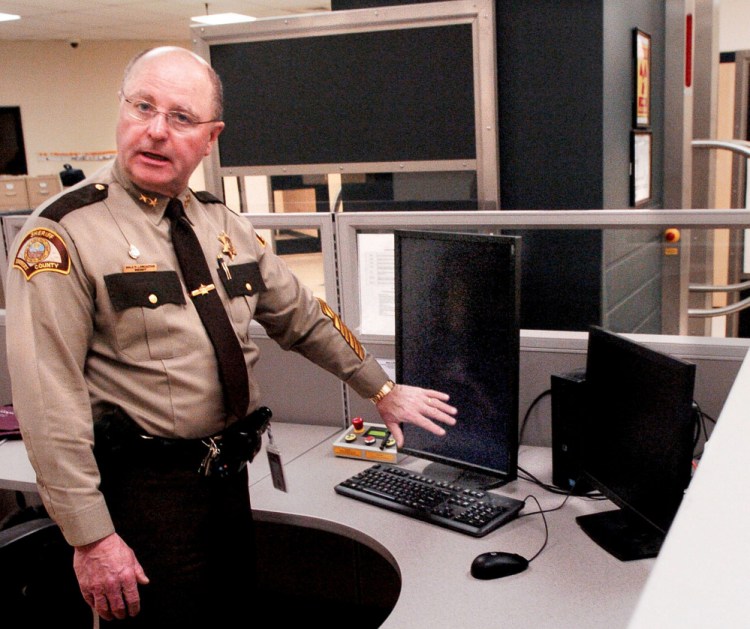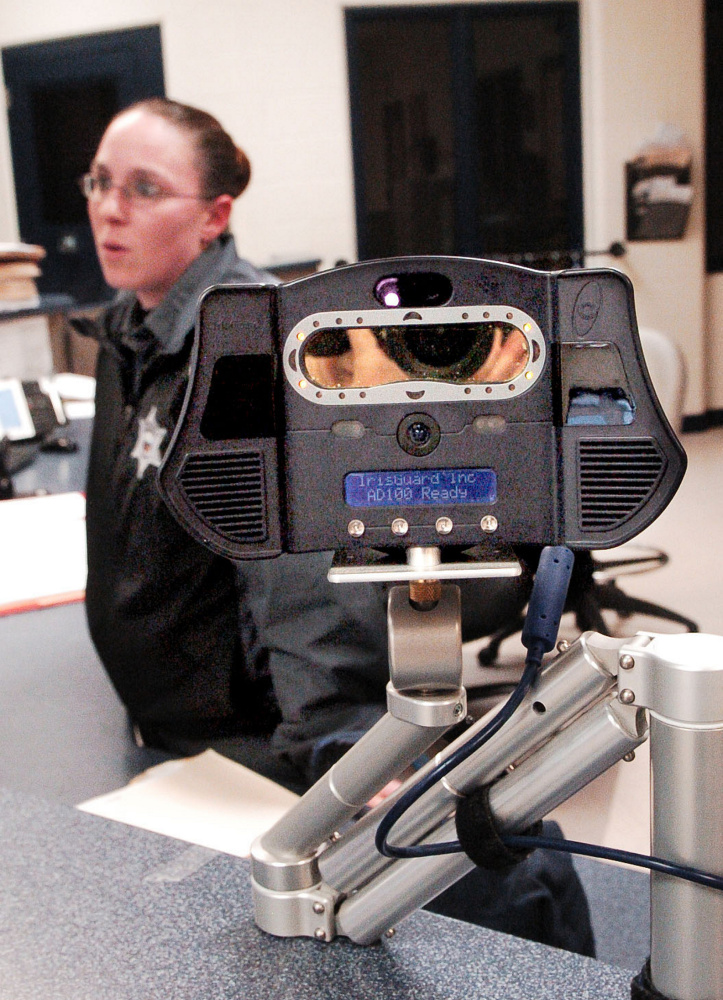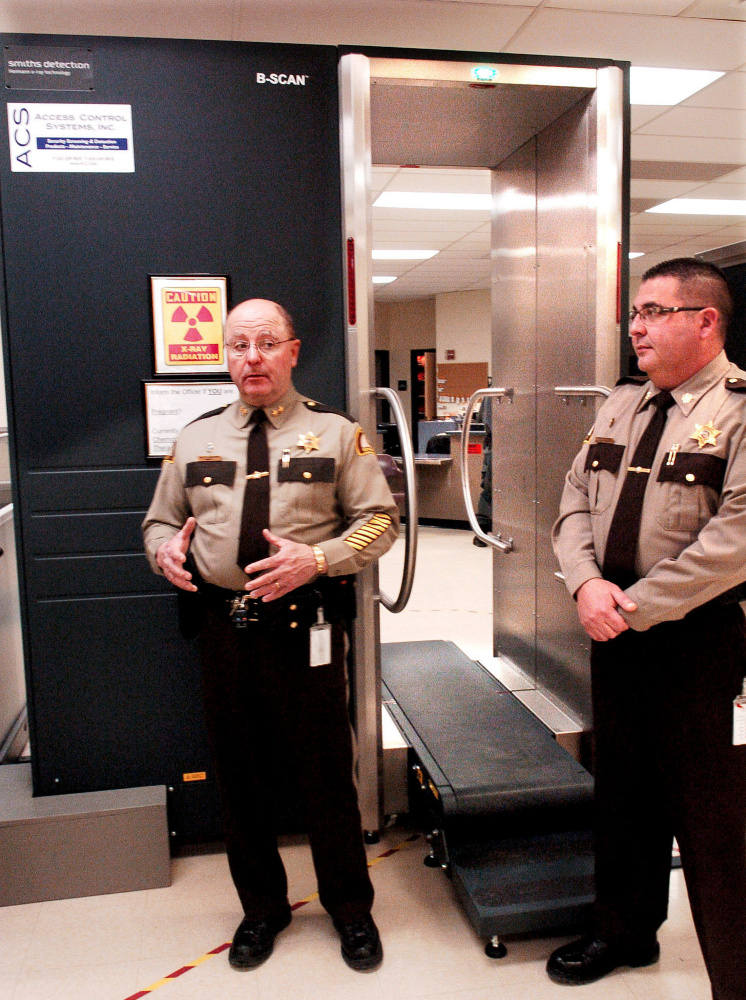EAST MADISON — In the parlance of corrections officials in Maine, a jail inmate is said to be “packing” if he or she is attempting to traffic contraband into a correctional facility.
Drugs. Weapons. Needles. Tobacco. Even cellphones.
Contraband can be swallowed in balloons or condoms and passed later, or secreted into a body cavity to be retrieved once the inmate is booked into the facility.
But the Somerset County Jail in East Madison is now the first, and so far the only, county jail in the state to put a dent in the trafficking of contraband with a device called the B-Scan, Sheriff Dale Lancaster said. The B-Scan is a low-power X-ray machine that looks inside a person for organic or metallic items being smuggled into the Somerset jail, which currently houses about 100 inmates. Findings from the X-ray scan are projected onto a computer screen in the jail’s sprawling booking room and the item is removed, either voluntarily by the prisoner or, if necessary, under Fourth Amendment rules, with a court-approved search warrant based on probable cause evidence from the B-Scan.
There is one other such machine in use in Maine, and that is at the Maine State Prison in Warren, according to Gary LaPlante, director of operations at the state Department of Corrections. He calls the machine “just another tool in the toolbox.”
Oxford County Sheriff Wayne Gallant, the new president of the Maine Sheriff’s Association, who took office Thursday, said the scanner at the Somerset County Jail is the only one in a county jail in Maine.
Being the first county jail in Maine to get a B-Scan machine, Lancaster said, the Somerset jail received about a $50,000 discount and officials were provided with training on the new technology at no cost. He said he worked with Somerset County commissioners to pay the $200,000 for the machine from boarding fees charged for federal inmates.
That federal boarding revenue is divided into three areas — operations, debt service on the construction of the jail in 2008, and capital expenditures — an amount accumulated over the past couple of years.
“The money didn’t come from the Somerset County taxpayer,” Lancaster said. “We felt that in a very short period of time, because of our costs saving on our one-on-ones, we would recoup those costs; and in addition to that, we would have a more secure facility.”
The U.S. Supreme Court in 2012 ruled that guards may strip-search even minor traffic offenders routinely when they are arrested and detained, a ruling that also provides applies to searches during incarceration.
Often, said Lancaster and Jail Administrator Cory Swope, just seeing the the machine encourages an inmate to give up willingly what he or she is hiding, rather than face possible charges. Since the device was first put into service in July, six people have been caught with contraband, mostly trying to smuggle in strips of Suboxone, a powerful opioid.
“It’s saving the county money. It’s less stress on the staff and makes for a safer environment inside,” Lancaster said. “Prison contraband has always been an issue. Part of the sheriff’s office job is not only to protect the inmates and the officers, but to stop contraband from entering into the facility. That does compromise everyone’s safety once contraband gets in.”
The B-Scan, a whole body scanner made by Smiths Detection, is a large metal scanning device standing 10 feet off the booking room floor. An inmate enters the machine via a step onto a conveyor belt with metal handles, where he or she stands sideways and the machine rolls the inmate through. Swope said the machine is one of several security measures installed at the jail.
“This is an augmentation,” he said. “It doesn’t replace our other searches that are conducted. This is just an enhancement.”
An inmate enters the jail’s intake booking room, where he or she passes through a metal detector, is processed with an iris scanner of the eyes for nationwide identification and to a modern mug shot camera and fingerprint computer where images are sent directly to the state Bureau of Identification in Augusta.
It takes 45 minutes to an hour to book a prisoner fully, Lancaster said. He said another security measure is that the jail has a no-contact visiting policy, in which visitors are behind a glass window where they can see and talk with the inmate but cannot pass along any contraband through a caress or a kiss.
Lancaster added that six other county jails in Maine bring inmates suspected of concealing contraband inside their body to the Somerset jail to be scanned, then take them back to the home jail, where authorities deal with the inmate if something is found. Trafficking in prison contraband is a class C felony, punishable by up to five years in prison.
The same type of scanners are used to uncover illegal drug and other contraband smugglers as well as potential terrorists worldwide. They are used at airports, customs checkpoints and border crossings.
The body scanners of old were able to detect concealed metal, but whole body scanners such as the one at the Somerset County Jail can detect both metallic and organic materials with a quick, simple scan, according to a report by correctionsone.com
Lancaster and Swope said weapons in a jail — even piercings — can be a problem when fights break out.
“That is a real problem for the inmates and the officers,” Lancaster said. “We do have altercations that occur inside the jail from time to time. Whenever you introduce a weapon, people can get hurt, seriously hurt.”
Lancaster said the old way of screening an inmate for contraband involved monitoring that person in isolation 24 hours a day in a closed or “dry” cell with no water and no toilet. The inmates was watched and supervised through three complete bowel movement cycles, whether it took three days, or in one case, 10 days. The practice is called one-on-one supervision. The officer on duty also had to make sure there was no contraband in the inmate’s stool.
The guard was paid overtime because it was above and beyond his or her regular staffing duties. With the new scanner and other devices in the jail’s booking area, taxpayer money is saved, Lancaster said.
Now every inmate is scanned by the machine, with a few medical exceptions, eliminating that one-on-one monitoring.
“As I was doing the evaluation, we found we were spending an inordinate amount of money doing our one-on-ones,” the sheriff said. “The 10-day watch cost the county over $6,000.”
Doug Harlow — 612-2367
Twitter:@Doug_Harlow
Send questions/comments to the editors.






Comments are no longer available on this story